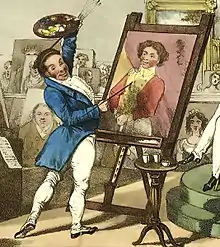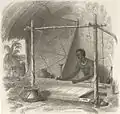Charles D'Oyly
Sir Charles D'Oyly, 7th Baronet (1781–1845), was a British public official and painter from Dhaka. He was a member of the Bengal Civil Service based in Calcutta, Dhaka and Patna from 1797 to 1838. He was also a talented and prolific amateur artist who published many books featuring engravings and lithographs featuring Indian subject matter.
Sir Charles D'Oyly | |
|---|---|
 Tom Roe sits for his portrait in Chinnery's studio by Charles D'Oyly, 1828 | |
| Born | 17 September 1781 |
| Died | 1845 |
| Nationality | British- Indian |
| Known for | Painter, sketcher, administrator, author |
| Movement | Orientalist; Cartoonist; Satirist |
Life and career
Charles D'Oyly was born in Murshidabad, India on 17 September 1781. He was the son of Sir John-Hadley D'Oyly, 6th Baronet and Diana Rochfort.[1] His father, was the resident of the East India Company at the Court of Nawab Babar Ali of Murshidabad. As a boy, D'Oyly went to England with the family in 1785 and received his first formal education there. In 1798 he returned to India as Assistant to the Registrar in the Court of Appeal in Calcutta. In 1803 he was appointed as 'Keeper of the Records' in the office of the Governor General.[2]
After the death of his father in 1818, D'Oyly inherited the baronetage and received a knighthood. D'Oyly was appointed as the Collector of Dacca (now Dhaka) in 1808. In the following years, he held posts as Collector of Dhaka from 1808 to 1817; City Collector of Customs in Calcutta (1818); d the Opium Agent of Bihar and the Commercial Resident of Patna (1821-1831) and lastly the Senior Member of the Board of Customs, Salt, Opium and of the Marine (1833). Between 1832 and 1833, D'Oyly took leave at the Cape of Good Hope, returning to Calcutta to fill the post of Senior Member of Customs, before retiring in 1838.
He married firstly Marian Greer, daughter of William Greer; and secondly Elizabeth Jane Ross, daughter of Major Thomas Ross. After serving with the company for forty years, his failing health compelled D'Oyly to leave India in 1838. The greater part of the rest of his life was spent in Italy. D'Oyly died in Italy on 21 September 1845 without issue.[3]
During his time in Dacca, he painted a wide variety of pictures, especially the Mughal ruins which he published in a folio-size book with fifteen engravings entitled Antiquties of Dacca (now Dhaka in Bangladesh) in London 1814 and in various reprints from 1823 onwards. A short historical account of Dhaka was also appended to each book. James Atkinson wrote these accounts, with engravings by Edwin Landseer. The Antiquities of Dacca became an important social document of the period.
Whilst in Dacca, D'oyly met the celebrated artist, George Chinnery,[4] who spent a great deal of time staying with D’Oyly during his early career. The pair became close friends and went on several expeditions together. Chinney had a considerable influence on the development of D'Oyly's artistic style. D'Oyly collaborated with Christopher Webb Smith in producing a number of books. Two of these were Feathered Game of Hindostan (1828) and Oriental Ornithology (1829), Webb Smith depicting the birds and the foliage, and D'Oyly doing the backgrounds.[5] One of D'Oyly's most productive periods was while he was Patna (1821-1831), where he sts of producing numerous paintings and sketches.
In 1848 Dickinson & Co., 114 New Bond Street, London, published D'Oyly's Calcutta drawings in a large folio-size book titled Views of Calcutta and its Environs in 1848. The original drawings for this work were probably made between 1833 and 1838 while D'Oyly was Senior Member of the Board of Customs, Salt, and Opium and Marine Board in Calcutta, but some must have been completed between 1839 and 1845 when he retired. The complete work was published after D'Oyly's death in Italy in 1845.
Gallery
Engravings from D'Oyly's Antiquities of Dacca first published c. 1814
.jpg.webp) Bastion of the Lal Bagh, Dacca
Bastion of the Lal Bagh, Dacca Account of Dacca a Hut beside a Tomb
Account of Dacca a Hut beside a Tomb A Tantee or Indian Weaver
A Tantee or Indian Weaver Mosque on the Mug-Bazar road, Dacca
Mosque on the Mug-Bazar road, Dacca.jpg.webp) Remains of a Bridge near the Tantee Bazar, Dhaka
Remains of a Bridge near the Tantee Bazar, Dhaka.jpg.webp) Ruins of Tungy Bridge
Ruins of Tungy Bridge.jpg.webp) Paugla Pool, with Part of Dacca in the Extreme Distance
Paugla Pool, with Part of Dacca in the Extreme Distance Part of the Interior of the City of Dacca
Part of the Interior of the City of Dacca
Prints from D'Oyly's Views of Calcutta and Environs, 1848
 Views of Calcutta and Environs
Views of Calcutta and Environs Mosque at Borranipore
Mosque at Borranipore Town and Port of Calcutta
Town and Port of Calcutta View on the Serampore Road
View on the Serampore Road View in Clive Street
View in Clive Street
Arms
_Achievement.png.webp) |
|
See also
| Baronetage of the United Kingdom | ||
|---|---|---|
| Preceded by John Hadley D'Oyly |
Baronet (of Shottisham) 18184–1845 |
Succeeded by John Hadley D'Oyly |
References
- The Peerage Online,http://www.thepeerage.com/p37206.htm
- http://www.christies.com/LotFinder/lot_details.aspx?intObjectID=4147631
- Debrett, J., The Baronetage of England, Volume 1, 1824, p. 325; 'The Peerage Online,http://www.thepeerage.com/p37206.htm
- Sotheby's, Catalog Note, Online: http://www.sothebys.com/en/auctions/ecatalogue/2012/modern-and-contemporary-south-asian-art-including-indian-miniature-paintings/lot.17.html
- "Extracts from the Book 'Indian Life and Landscapes by Western Artists'". Archived from the original on 2011-02-25. Retrieved 2011-01-23.
- Debrett's Peerage. 1985.
Further reading
| Wikimedia Commons has media related to Sir Charles D'Oyly, 7th Baronet. |
- Losty, J.P., "A Career in Art: Sir Charles D'Oyly", in Under the Indian Sun: British Landscape Artists, P. Rohatgi and P. Godrej (eds), Bombay, 1995, pp. 81–106